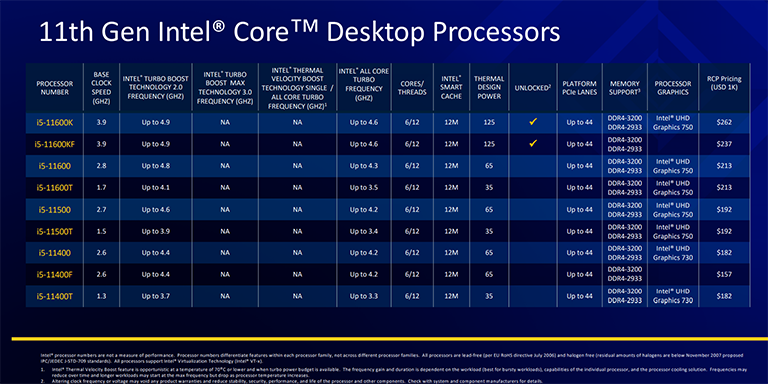Introduction
Intel's 11th Gen Core desktop chips broke review cover last week. Improving IPC from the last generation by around 20 per cent through backporting newer CPU technology alongside improved integrated graphics, we were nevertheless left unimpressed by the range-topper Core i9-11900K. Why? Fewer cores and sky-high power consumption did it no favours at all. We urge you to read the original review to find out just how Intel has engineered this one-shot range.
Yet there is more merit further down the stack as Intel's Core i5 and Core i7 offerings match up better with the AMD Ryzen competition. The next on the review block is the Core i5-11600K, headlining the range, and priced at $262 (£250).
One of nine chips to carry the Core i5 branding, its six cores and 12 threads run at up to 4.9GHz. All-core frequency is a solid (up to) 4.6GHz while TDP is 125W. It's prudent to ignore Intel's power budgets, at least for K-series chips, because most motherboards tend to supply more juice in an effort to extract the most performance. Motherboard BIOSes allow the chip to configure TDP down to 95W, albeit at obvious cost to performance.
Core i5 is at the bottom of the current 11th Gen Core portfolio. Even so, we think the 11600K is not the chip to go for because its performance-to-value play is not that strong. If it was our money, something like the Core i5-11400F (£150) and an inexpensive B560 board (£90) would be better suited to a mid-priced build, or even a last-gen Core i5-10400F and B460 (£190 combined) if you're not bothered by the improved IPC and PCIe 4.0 capability. We say this with the knowledge that next-generation Core on the desktop, known by the codename Alder Lake, is set to arrive this year. Armed with a new socket and fundamentally more performance, spending big now isn't a smart move.
Those that need to invest now ought to be buoyed by the fact that Intel produces 11th Gen Core on older, mature 14nm technology, which actually works out well in the mid-range space. It can churn out volume without obvious issue, at least for the next quarter, whereas AMD's use of premium, low-capacity 7nm for the Ryzen 5 5600X increases that chip's current price by decreasing availability.
Mainstream Pricing Comparison At Select Points |
|||
|---|---|---|---|
| Price | Intel Core 10/11 Gen |
AMD Ryzen 3/5 Series |
|
| £300-£350 | - |
R5 5600X (6/12) |
|
| £250-£300 | - |
- |
|
| £200-£250 | i5-11600K (6/12) i5-11600KF (6/12) i5-11600 (6/12) |
R5 3600X (6/12) |
|
| £150-£200 | i5-11400F (6/12) i5-11500 (6/12) |
R5 3600 (6/12) |
|
| £100-£150 | i5-10400F (6/12) |
- |
|
This important point is made clearer by a brief look into the cost of purchasing either Core i5 or Ryzen 5 today. The table shows in-stock banding for various processors, and while the latest Ryzen 5 5600X is available and likely to be a higher-performing part, its £325 street price is also rather steep. AMD does have more volume on last-gen Ryzen 5 parts, meanwhile, but they miss out on Zen 3 smarts.
One needs to think more about the entire platform cost when evaluating chips such as these. In that regard, Intel does okay here, especially if you need access to onboard graphics, though having no cooler in the box does murky the absolute picture a little more. Swings and roundabouts.
On a technical level, expect the Core i5-11600K to perform 20 or so per cent better than last-gen Core i5-10600K in applications that take advantage of the modest frequency uplift and improved IPC. Gaming ought to be largely the same based on the evidence presented in the Core i9-11900K review, and PCIe 4.0 is only beneficial for those running the very latest NVMe SSDs.
Offered in the familiar LGA 1200 form factor, it works best on a 500-series motherboard and can function mostly fine in a 400-series board.











